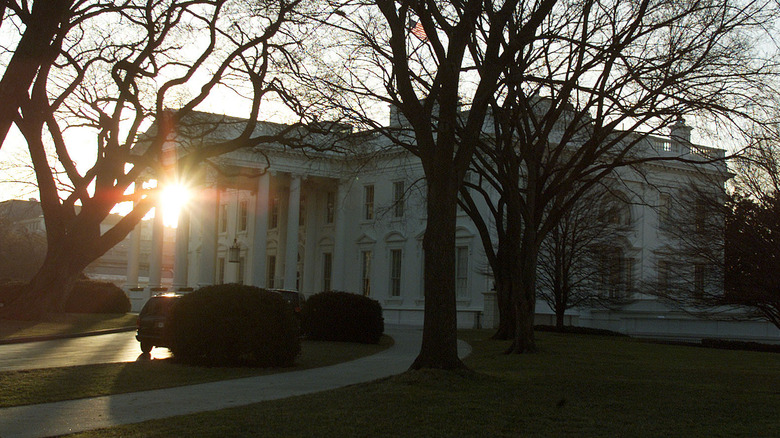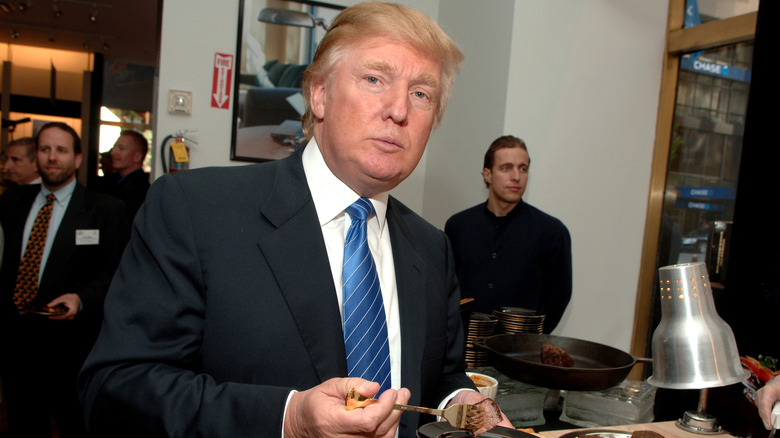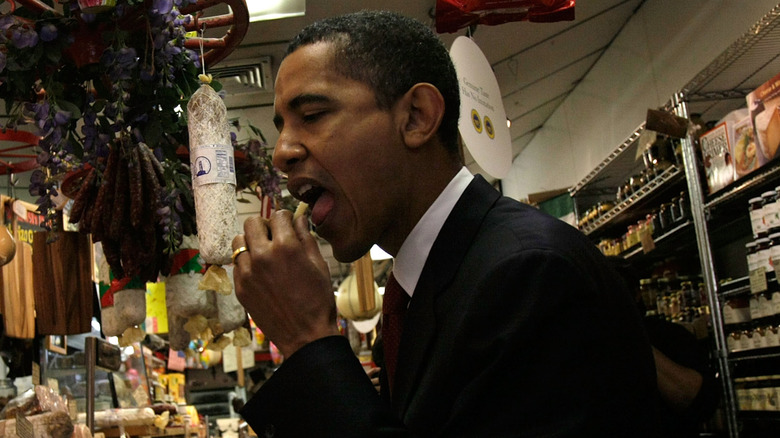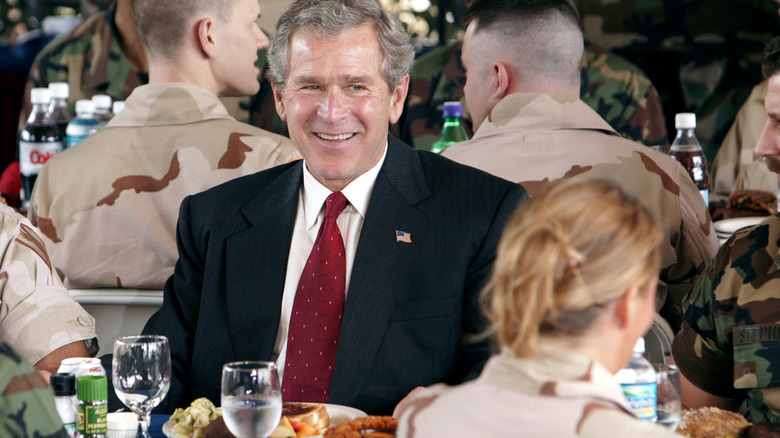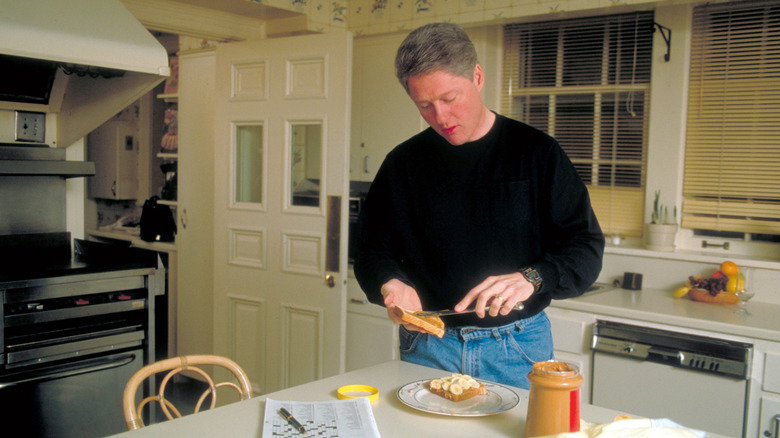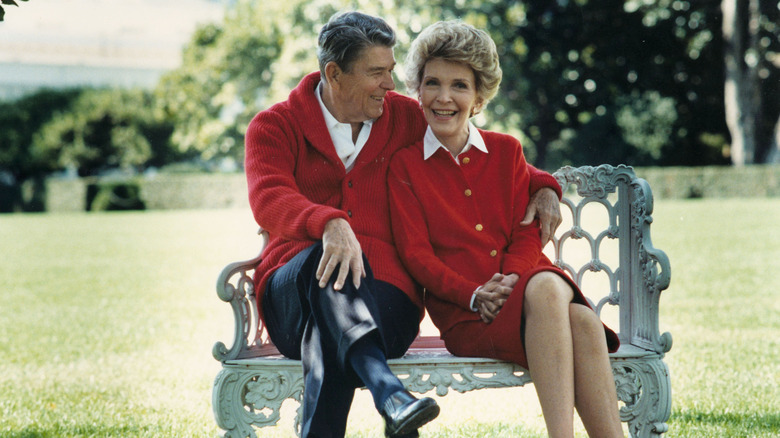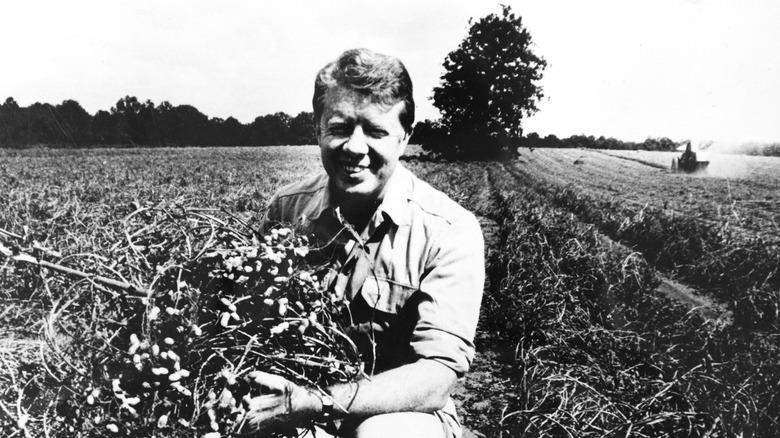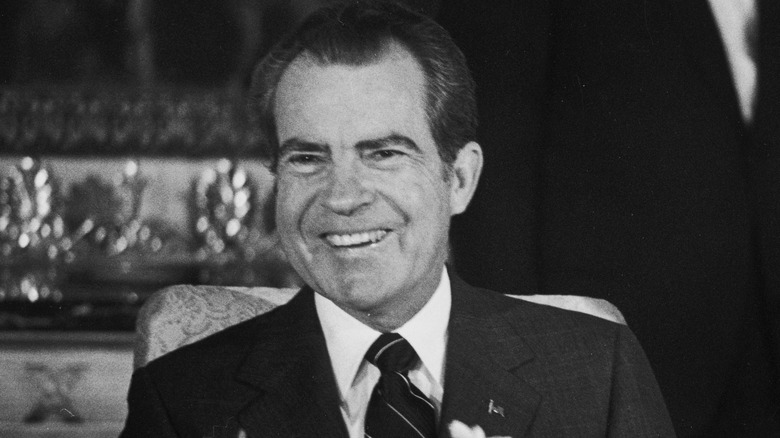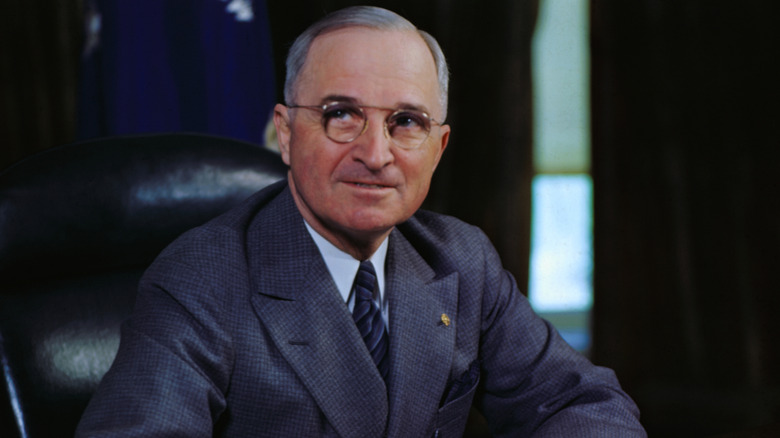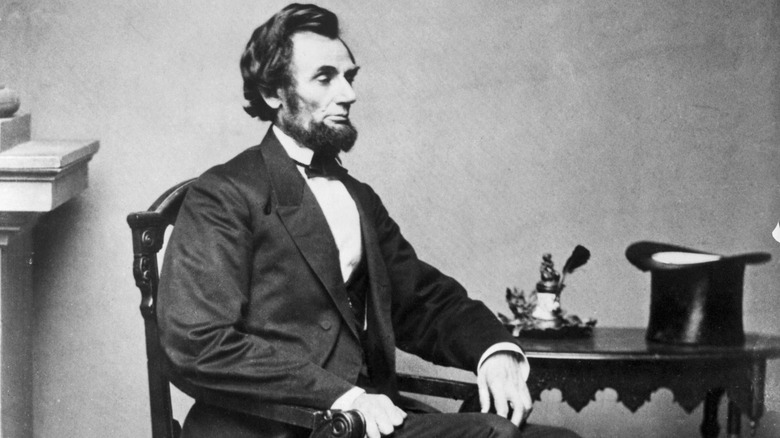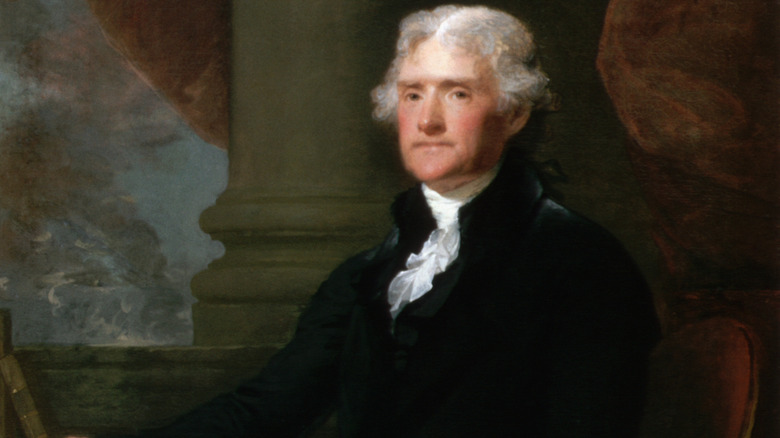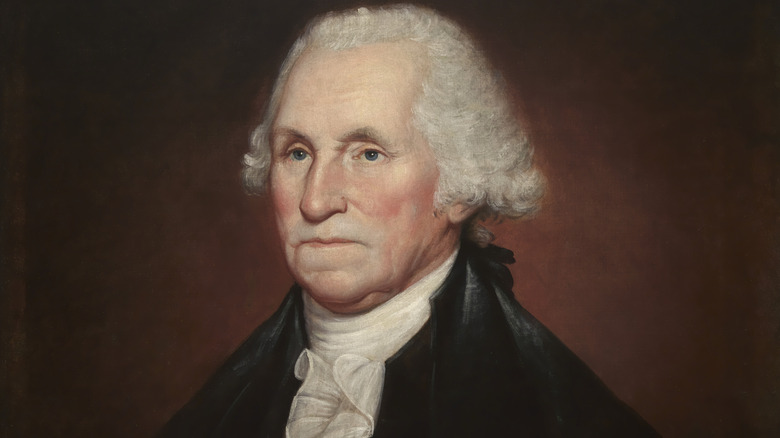The Favorite Breakfasts Of America's Presidents
At first glance, inspecting and dissecting what U.S. presidents eat for breakfast might seem like a frivolous pastime — mere trivia for history buffs and foodies. But look a little closer, and you will see that what they ate does matter. The dishes and drinks the various presidents have preferred can shape industries and influence how Americans eat. Food at the White House has often mirrored the cultural shifts of the times, whether it's the austere frontier-style meals enjoyed by Abraham Lincoln to Barack Obama's focus on sustainable and local produce.
So, when we deep dive into what has been served for breakfast at the White House, and what a president chooses to eat (or skip) first thing in the day, we are not just peeking into their kitchens but rather tracking the cultural currents. When these leaders chugged a coffee or grabbed a burger over a home-cooked meal, their choices went on to shape not just public perception, but also food industries eager to ride the presidential wave. Because in the highest office, food is never just food but rather a symbol, a statement, and sometimes, a strategic decision.
Donald Trump: Bacon and eggs
President Donald Trump may have built a persona based on luxury and excess, but his breakfast routine is surprisingly meager. That is, if he chooses to have breakfast at all. In an interview with Fox News in 2016, Trump famously declared, "I try and avoid breakfast actually." His go-to choice is the classic pairing of bacon and eggs when he does deign to eat. In an interview with People magazine, he stated his preference for his bacon cooked medium and eggs over well. His former butler, Tony Senecal, corroborated this in an interview with The Palm Beach Post.
But these "normal" meals are rare, and Trump often goes 14 to 16 hours without eating. He famously avoids coffee, tea, or alcohol and, like many of us, is a fan of Diet Coke instead. According to a 2017 article in The New York Times, he reportedly consumes up to 12 cans of Diet Coke daily. This allows him to lean in hard on the meal he prefers, which is dinner. Trump's rejection of breakfast and love for unhealthy fast food feels very on-brand and embodies his motto to skip the small stuff and go big later.
Joe Biden: Special K
President Joe Biden's breakfast is a blend of nostalgia and no-nonsense. More often than not, Biden and his wife, Dr. Jill Biden, settle for a bowl of Kellogg's Special K — sometimes with yogurt, or accompanied with eggs or toast. The Bidens pride themselves on managing breakfast on their own. Biden explained in an interview with People, "Jill and I, we come from middle-class backgrounds ... The guys who run the kitchen on the second floor, we don't have them come in to do breakfast works, because there's no need for them to have to do breakfast, whereas we can make our own eggs or pour a bowl of cereal."
And unlike many who fuel up for the day with coffee, Biden reaches instead for his trademark orange Gatorade as his morning pick-me-up of choice. On family weekends in Delaware, he is known to take his grandchildren out to a local cafe, but the fare was always traditional and uncomplicated. This straightforward breakfast routine echoed through the rest of his eating habits. Lunch might be a peanut butter and jelly sandwich or a BLT; dinners leaned toward pasta with tomato sauce. But breakfast set the tone for his time in office — predictable and rooted in routine.
Barack Obama: Eggs, potatoes, and wheat toast
Quite possibly one of the fittest presidents while in office, Barack Obama started his day with four to six eggs, potatoes, and wheat toast. Sometimes there would be fruit or bacon thrown into the mix, but by and large, Obama followed a lean and wholesome diet. This also may be thanks to Michelle Obama's influence and her famous White House vegetable garden, to prove that growing your produce is easier than you think, and raised awareness for healthy eating (values the Obamas held dear). Not to say there were no indulgences; reports from his campaign trail spotted him grabbing chocolate-covered donuts or takeout burgers once in a while.
Obama also rarely drank coffee in the morning, preferring water instead of orange juice. His former aide, Reggie Love, confirmed that coffee was never a big part of Obama's routine, no matter how demanding the day ahead (though he did choose green tea often). In addition to this protein-heavy, balanced breakfast, Obama included a daily 45-minute workout session before starting his work day. Beyond breakfast, Obama's favorite food is chili, made with either turkey or beef and seasoned with red wine vinegar, turmeric, and basil. But breakfast included eggs, toast, and potatoes. Simple, solid, and consistent.
George W. Bush: Huevos rancheros
President George W. Bush's eating habits were reflective of his down-to-earth and unpretentious tastes. In keeping with breakfast norms (unlike many other presidents), Bush started his day with a cup of coffee (in fact, he was a known caffeine lover). One of his favorite breakfast dishes was huevos rancheros. This Mexican dish consists of eggs, avocado, and salsa, topped with mounds of melted cheese. Bush's other preferred meals also veered toward the heavily spiced and flavorful (like the peculiar cheeseburger pizza he created), indicative of his preference for calorific (albeit tasty) comfort food.
But despite these over-the-top dishes, the homey, American flavors, rather than sophisticated and complicated meals, are what endeared him to the public. His breakfast table often mirrored his down-to-earth persona, and his quirkiness added to his relatability. Whether at the ranch or the White House, Bush's breakfast reflected a love for simplicity, tradition, and a little Southern heart.
Bill Clinton: Egg McMuffins
President Bill Clinton was well-known for his love for rich, hearty food, and had an insatiable appetite for the good things in life. Famous for regularly indulging in cinnamon rolls and Egg McMuffins for breakfast, all this changed after a health scare in 2004. Heart surgery coupled with a forced U-turn to his diet led Clinton to completely transform his lifestyle.
On the advice (and after a critical letter from) cardiac expert Dr. Dean Ornish, Clinton's revised breakfast consisted of a power-packed berry smoothie, realizing the importance of protein powder in a daily fitness routine. This soon led him to take on a new commitment to health and diet-related diseases prevalent in the country. In time, his foundation — The Clinton Foundation — worked toward promoting healthier lifestyles that he believes have far-reaching consequences on the nation's quality of life and economics. In an interview with AARP magazine, he declared, "I wanted to do it because this health and wellness work I've been doing is increasingly important to me."
But Clinton hasn't abandoned comfort and creativity entirely. About once a week, he makes room for some flexibility in his schedule and adds organic salmon or an omega-3-fortified omelet to keep his nutrient levels balanced.
Ronald Reagan: Fruit and cereal
Every morning at 7:45 a.m., President Ronald Reagan and his first lady, Nancy, would sit down for breakfast together. It was a ritual that rarely changed over the years in office and indicated the discipline and simplicity the Reagans favored. They enjoyed juice, fruit, cereal, and decaffeinated coffee to start of the day. Once a week, the couple indulged in a single egg each — served in different ways, such as scrambled, soft-boiled, or poached. The president often added on whole wheat toast or a muffin.
This simple spread matched Reagan's desire to stay fit during his demanding presidency. His habits, while largely focused on his health, were not without the occasional treats. He was known for his penchant for jelly beans, and always had some on hand in the Oval Office. Plus, he enjoyed the caramelized indulgence of Monkey Bread as a special treat. Raised in Illinois, his diet was heavily influenced by the Midwest tastes for comfort food and simple dishes, such as meatloaf and macaroni and cheese. But where breakfast was concerned, Reagan was all about keeping things simple and consistent.
Jimmy Carter: Fruit and toast
It should come as no surprise that President Jimmy Carter woke daily at 5:30 a.m., disciplined and dedicated to his routine. As the oldest and longest living president in U.S. history, Carter's approach to his diet was a blend of ritual and Southern tradition. He typically enjoyed a light breakfast that consisted of coffee, fruit, toast with butter, and freshly-squeezed juice. Occasionally eggs or cereal made an appearance, but on the whole, the family leaned toward fresh fruit and vegetables.
On the weekends, breakfasts were a bit heartier, reflecting his Southern upbringing. Country-style ham with red-eye gravy, scrambled eggs, hot fried apples, and grits were among the popular items served. Carter's love for grits was legendary, and he even went as far as naming his dog after his favorite dish. Despite his love for home-cooked Southern fare, Carter's diet was also shaped by the health-conscious movement of the 1970s. He was one of the first presidents to advocate for heart health and a balanced diet, and along with the American Medical Association, worked toward changing the way the nation viewed diet and lifestyle diseases.
The Carters proceeded to walk the talk and made choices like avoiding store-bought condiments and consuming less bread, encouraging people to exercise, get regular check-ups, and maintain a modest diet. Carter continued to be this simple and grounded man and was much loved by the American public, who valued his relatability both during his time in office and for years after.
Richard Nixon: Fruit and wheat germ
On the advice of his grandmother and his doctor's request to eat more dairy, President Richard Nixon began a most unusual morning routine. This included his regular breakfast of fresh fruit and wheat germ, along with a bowl of cottage cheese ... topped with ketchup! Supposedly, this was a trick his grandmother taught him to make the dairy product more palatable, and Nixon swore by it. During a White House Conference on Food, Nutrition, and Health in 1969, he explained, "The difficulty is I don't like cottage cheese. And so I said I took his advice, but I put ketchup on it ... And others wrote and said that ketchup with cottage cheese had to be unhealthy. I pointed to the fact that my grandmother lived to be 93 and she ate it all her life."
There were also times when he changed things up and opted for cottage cheese and pineapple instead. This was famously served as his last meal in the White House before he resigned in 1974. The fact that cottage cheese was at its most popular during Nixon's time in office may not be a mere coincidence.
John F. Kennedy: Soft-boiled eggs
With their innate style, class, and sophistication, it's no surprise that Americans wanted to know the smallest details about John F. Kennedy and his wife, Jackie. The glamorous couple's daily routine continues to captivate the nation even today. However, JFK's simple breakfast choices were more a reflection of his New England upbringing rather than the couple's dazzling lifestyle.
It is said that he favored a simple morning routine that included soft-boiled eggs, toast with butter, and orange juice. He also preferred marmalade over jelly and oven-broiled bacon slices rather than fried. This was specified in a note to the family's chef, where Jackie Kennedy emphasizes that "Mr. K can eat nothing fried." This straightforward breakfast mirrored the rest of his daily meals, which were also light and simple.
The only time this morning ritual varied was when the White House served his famous waffles made from scratch. These buttery, sugary treats were lavished with hot maple syrup and relished by the family. But more often than not, Kennedy was known to have a light appetite, gravitating toward easy, familiar dishes over anything lavish. Even on his last morning, Kennedy's breakfast was remarkably unostentatious. A five-minute soft-boiled egg, broiled bacon, fresh orange juice, and coffee with hot milk — a meal as restrained and consistent as the man himself.
Harry S. Truman: Eggs, toast, bacon ... and bourbon
President Harry S. Truman's morning routine may have raised eyebrows, but he persisted, undeterred. Most days began at 5 a.m. with an intense walk (more often than not dressed in a full suit and tie). What followed was a breakfast ritual that truly stood out. This included a physician-approved shot of bourbon followed by a large glass of orange juice. "It gets the engine running," Truman reportedly said, favoring brands like Old Grand-Dad and Wild Turkey.
Following his morning constitutional and "medicine," Truman would settle into a classic American breakfast of eggs, toast, bacon, cereal, and a tall glass of milk. This ritual continued unchanged no matter where he was, and reports from his stays at the Little White House in Key West show an identical start to the day, mirroring his practical leadership style and commitment to routine. One has to understand that Truman's boozy breakfast wasn't just a personal quirk. It played an important part in shaping his image as a tough Midwesterner who appreciated the simple pleasures of life and was unafraid to show his true self to the public.
Woodrow Wilson: Raw eggs and grape juice
While in office, President Woodrow Wilson and his slender physique were the source of much consternation for the White House physician. In a bid to improve the president's health and increase his weight, a peculiar breakfast drink was concocted. Made with two raw eggs blended with Concord grape juice, this lavender smoothie-looking drink was packed with protein and vitamins. However, today we know that the consumption of raw eggs can be extremely dangerous and lead to severe illnesses. With this disclaimer at the forefront, the website Cooking with Congress even gives a detailed recipe for the same.
This unusual drink is a far cry from the first Wilson family breakfast at the White House, which consisted of oranges, cereal with cream, bacon and eggs, steak, hotcakes, toast, tea, and coffee. During the nationwide shortage of wheat in World War I, Wilson's second wife, adapting to the times, used to treat him to cornmeal pancakes. Still, the raw egg and grape juice drink remains one of the more peculiar presidential breakfast habits in American history, showcasing how the president's health influenced his eating habits.
Abraham Lincoln: One egg with toast
Much has been written about President Abraham Lincoln's indifference to food. According to his secretary, John Hay, President Lincoln "ate less than anyone I know." Historian Helen Dupre Bullock notes that Lincoln was rarely interested in what was served or how it was prepared. He often forgot to eat unless reminded, his mind consumed by the nation's affairs. Even his wife, Mary Todd Lincoln, once remarked that they "dine in the plainest manner," underscoring his lack of interest in lavish meals. Unsurprisingly, breakfast for Lincoln was a meager affair and one which he rarely included in his morning routine. If he did eat, it would be an egg with toast and coffee, at best.
Yet, despite his modest appetite, Lincoln did have certain foodie favorites — many of them hinting at his Midwest roots. Apples were a lifelong favorite, and he reportedly ate them whole, core and all. He also enjoyed simple snacks like fresh fruit and nuts, cheese, and crackers. Historian Suzy Evans points out that Lincoln never lost his taste for the simple foods of his youth. These included dishes like Kentucky corn cakes, gooseberry cobbler, gingerbread cookies, and corn dodgers. It's easy to see that these eating habits hinted at a man who always prioritized the nation over his own needs.
Thomas Jefferson: Coffee with muffins, cornbread, and ham
At Monticello, President Thomas Jefferson's breakfasts were a ritual that combined entertainment, a gathering of family and friends, and a touch of European elegance. Like many Americans at the time, the Jeffersons followed the custom of eating only twice a day. There was usually a substantial breakfast around 8 a.m. and dinner in the late afternoon.
Accounts from visitors like Margaret Bayard Smith and Daniel Webster paint a vivid picture of Jefferson's table. It was laden with tea and coffee, fresh from imported beans he selected, alongside muffins, hot wheat, cornbread, cold ham, and butter.
Coffee held a special place at Monticello. Jefferson, an aficionado, considered coffee "the favorite beverage of the civilized world." Large quantities of imported, unroasted beans were said to be stocked in his cellars and the staff were reportedly trained to follow his detailed brewing method, serving coffee in a silver urn of his own design. Even amidst the bustle of political guests (of which there were plenty) and family (even more), Jefferson's breakfasts remained orderly yet lively.
George Washington: Hoecakes
According to President George Washington's step-granddaughter, Nelly Custis Lewis, he was an early riser who chose to write or read in the mornings before breakfast, which consisted of versions of hotcakes made of Indian meal (usually three portions). These were served dripping in butter and honey and were washed down by three cups of tea without cream.
Washington loved this meal of choice — also known as hoecakes — so much that he served them to several guests at Mount Vernon. The yeasted griddlecakes required preparation the night before; the batter was left to rise by the hearth overnight and then cooked on a griddle greased with beef suet or corned beef fat. The hotcake batter was then ladled by the spoonful and served immediately once it turned golden brown. Various versions of the recipe are available, but the main ingredients remain cornmeal, butter, and honey. In Washington's company, this innovative and filling meal was accompanied by several cups of hot tea, usually served without cream, as a nod to the austerity of the time.
